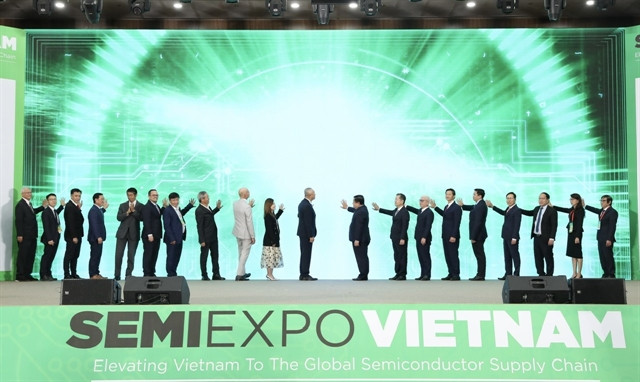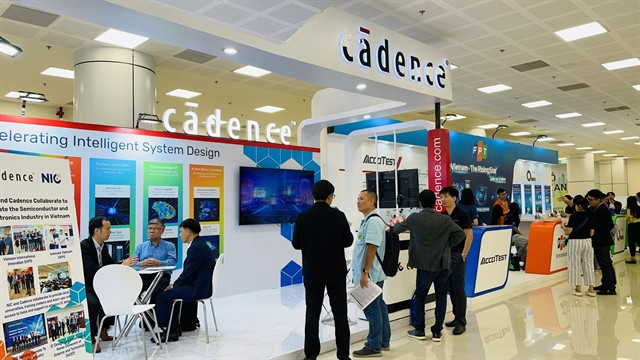| Delegates help press the start buttons to inaugurate the event. — Photo courtesy of MPI |
With the theme, 'Elevating Vietnam to the Global Semiconductor Supply Chain', the expo is Việt Nam’s first and largest international semiconductor exhibition. Organised by the Ministry of Planning and Investment, in collaboration with the National Innovation Centre (NIC) and the Global Semiconductor Association (SEMI), it marks a significant step in Việt Nam’s journey to integrate into the global semiconductor value chain.
Minister Dũng emphasised that the semiconductor sector is crucial for Industry 4.0, serving as the backbone of breakthrough technologies such as artificial intelligence (AI), the Internet of Things (IoT) and big data. He pointed out that Việt Nam’s growth in this sector is not only an economic driver, but also strengthens the country’s standing within the global value chain.
Facing complex geopolitical challenges, countries around the world are looking to diversify their supply chains and secure reliable sources for essential components. Minister Nguyễn Chí Dũng highlighted that Việt Nam is in a strong position to attract semiconductor investment thanks to its political stability, rapid economic growth, along with a young, skilled workforce.
To support this vision, the Vietnamese government has introduced a strategic development plan for the semiconductor sector, with ambitious targets stretching to 2050. By 2030, Việt Nam aims to become a global hub for semiconductor talent and by 2040, it seeks to position itself as a major centre for semiconductor manufacturing.
To achieve these goals, Việt Nam is prioritising the development of a highly skilled workforce. By 2030, the country plans to train at least 50,000 engineers at the university level or higher, alongside 1,300 specialised faculty members and establish a network of laboratories meeting national standards.
The Ministry of Planning and Investment is actively working with international organisations and companies, including Cadence and Synopsys and leading universities to update curricula and integrate advanced software tools to meet the industry’s evolving demands.
| Visitors at the event. — VNS Photo Mai Hương |
Additionally, Việt Nam has created an appealing investment climate, offering numerous incentives to high-tech enterprises.
A new decree for an Investment Support Fund in the semiconductor sector is expected to be issued in 2024. High-tech parks in Hà Nội, HCM City, Đà Nẵng and the NIC are equipped with modern infrastructure and ready to support investors with preferential policies.
“Our goal is not only to join the global value chain but to establish a robust semiconductor ecosystem that makes Việt Nam an attractive and self-sustaining industry hub in the region and the world,” Dũng said.
President of GlobalFoundries Asia and SEMI SEA Regional Advisory Chairman, KC Ang, also acknowledged the rapid growth potential of the semiconductor industry. He highlighted that global semiconductor revenue is projected to exceed US$1 billion by 2030, a remarkable pace given that it took 50 years to reach $500 million.
“We are now poised to double this in less than a decade,” Ang said, reflecting the sector’s transformative speed. He also pointed to Việt Nam’s unique strengths, including strong governmental support, strategic location near major markets, abundant talent and investments from multinational firms like Samsung, Intel and Amkor.
The World Bank’s Country Director for Việt Nam, Cambodia and Laos, Mariam Sherman, outlined four elements key to Việt Nam’s success in becoming a global semiconductor hub: trade integration, clean energy production, knowledge transfer and workforce development. She emphasised that Việt Nam’s strategic location and political stability make it a prime choice for foreign investors, positioning it as a central node in trade networks and supply chains.
Sherman noted that the World Bank remains committed to supporting Việt Nam’s ambition to become a leading semiconductor nation by 2050.
The two-day event gathered over 5,000 attendees and 100 booths from key semiconductor technology players, including Qualcomm, Qorvo, Dassault Systemes, Siemens, FPT and Viettel.
A key highlight was the dialogue with semiconductor enterprises, led by the Minister of Planning and Investment, where experts and leaders discussed sustainable strategies for Việt Nam’s semiconductor industry.
At the opening, Minister Dũng and delegates witnessed the announcement of partnerships between the National Innovation Centre (NIC), SEMI and partners to boost Việt Nam's semiconductor industry. — VNS

